The ultimate guide to how to plant trees: 10 Easy Garden Trees
 Lee Burkhill: Award Winning Designer & BBC 1's Garden Rescue Presenters Official Blog
Lee Burkhill: Award Winning Designer & BBC 1's Garden Rescue Presenters Official Blog

Planting trees is a powerful solution in a world grappling with environmental challenges such as rising temperatures, droughts, heat waves and extreme weather. Knowing how to plant a tree play a vital role in mitigating climate change, improving air quality, conserving water, and providing habitat for countless wildlife species.
If you're passionate about positively impacting the planet, learning how to plant trees is an essential skill.
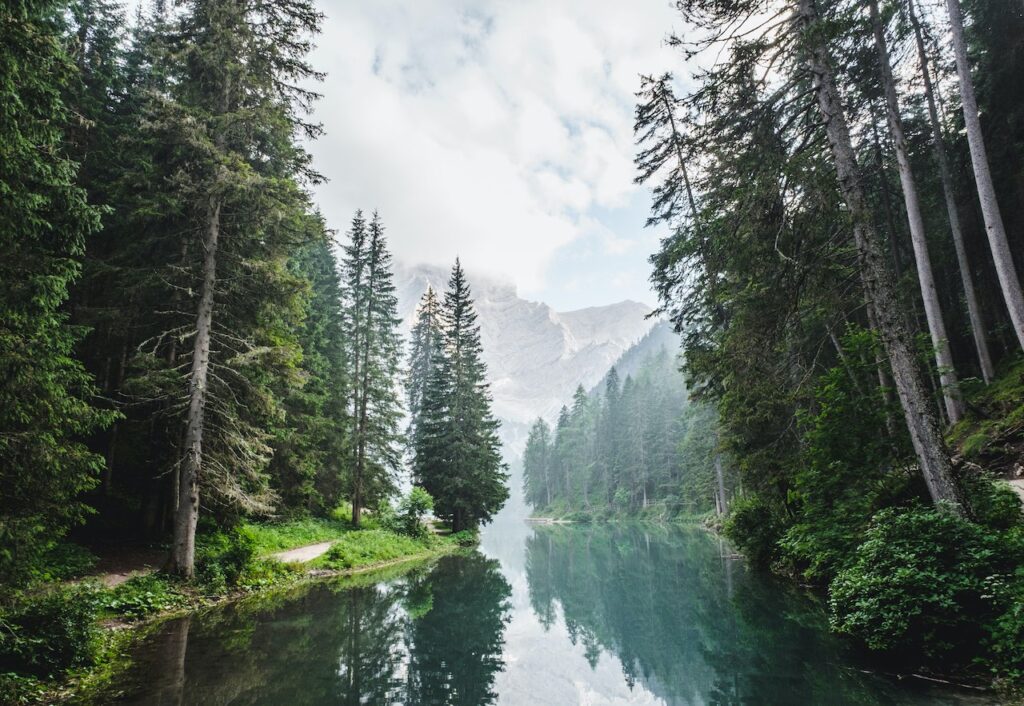
In this comprehensive tree planting guide, I'll take you through a step-by-step approach to how to plant a tree—helping you contribute to a greener garden future. So let's go!
(This guide contains affiliate links so if you do choose to buy from these I receive a small commission that helps keep this blog free to use!)
There are several reasons why planting trees in our gardens is important. In fact, even the smallest urban garden can accommodate a suitable tree. So let's take a look at a number of the benefits first before how to plant a tree.
Trees support a wide range of wildlife, making gardens more biodiverse and ecologically balanced. They provide shelter, nesting sites, and food sources for birds, insects, squirrels, and other creatures. By planting trees in your garden, you can attract and support a variety of beneficial wildlife, contributing to the local ecosystem. Fruit trees are also an essential source of early pollen for our honey bee population. Far richer than bulbs or tulips to help out honey bees before other perennials emerge with nectar.
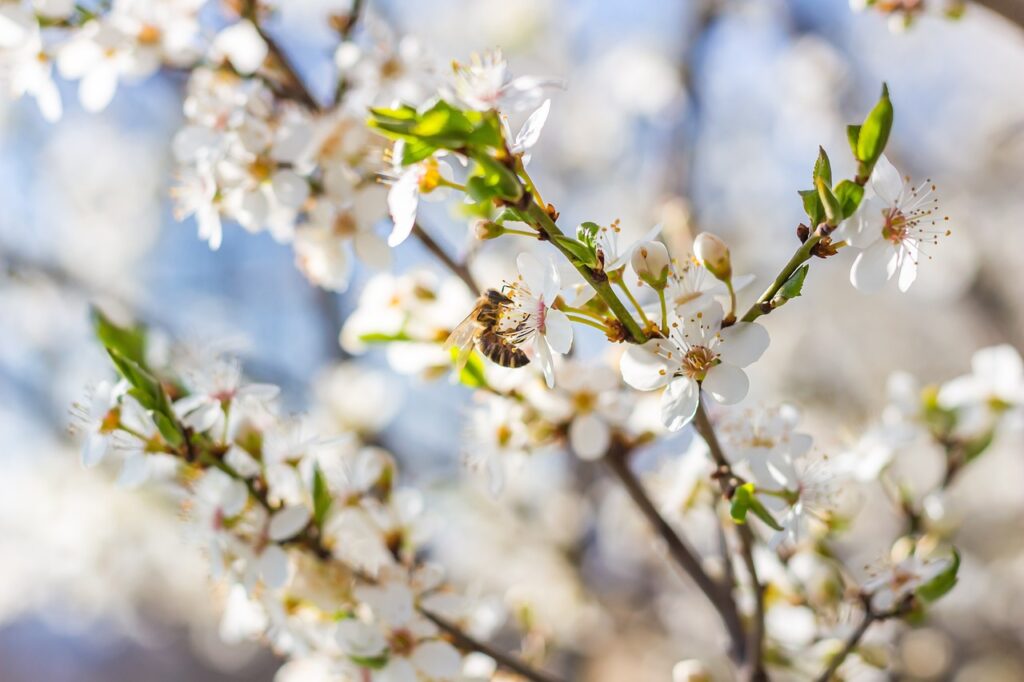
Trees provide much-needed shade, creating comfortable areas for relaxation and outdoor activities in the garden. They help reduce the intensity of sunlight, blocking harmful UV rays and lowering temperatures in the garden all without the need for ugly shade sails, parasols or expensive garden pergolas.
By strategically placing trees to shade buildings or paved areas, they can contribute to energy savings by reducing the need for fans, expensive garden buildings or even internal air conditioning as they cool the local environment. Imagine if every garden had a tree; how better the world would be at regulating heat, producing oxygen, not to mention the cleaner air we would all be breathing!

Trees are wonderful at providing cost-effective ways to save money by creating shade which is welcome in our heat-retentive concrete towns and cities.
Did you know that you can take my course and learn how to become a Garden Ninja yourself? Click here for details
Trees add natural beauty and visual appeal to gardens. They provide a vertical element that creates depth and structure, enhancing the overall landscape design. The diverse forms, textures, and colours of tree foliage, flowers, and bark contribute to the garden's aesthetics, creating a sense of tranquillity and visual interest.
Trees add much-needed height to garden designs helping smaller gardens look bigger and slowing down the view of the garden. This is why all successful garden designs have trees and height as a key design elements.
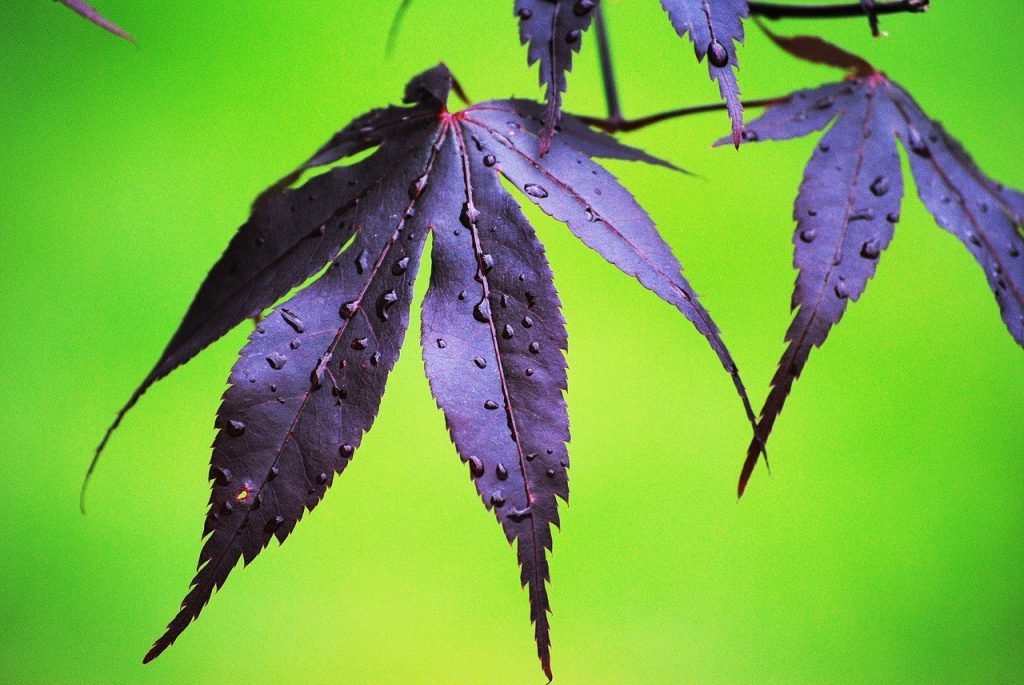
Trees can act as natural screens, creating privacy and reducing noise levels in the garden. They can block unwanted views, act as windbreaks, and create a sense of seclusion. Using trees strategically as privacy screens can enhance the enjoyment and usability of outdoor spaces. I've been vlogging about using plants and trees for privacy for years as part of my garden design practice. They are an overlooked weapon in any garden designer's toolbox!
Trees offer a better alternative to fences and a softer way to gently block out neighbouring views or nosey neighbours peering into your garden!
Trees have numerous environmental benefits that extend beyond the garden. They absorb carbon dioxide and release oxygen through photosynthesis, helping to mitigate climate change and improve air quality. Trees also provide shade and reduce evaporation, helping to conserve water and prevent soil erosion. Their root systems can help filter and absorb pollutants, improving soil quality and water infiltration.
Spending time in nature and surrounded by trees has been shown to have positive effects on mental health and well-being. Trees in the garden can create a sense of calm, promote relaxation, and reduce stress levels. They provide a connection to the natural world, allowing for reflection and a break from the fast-paced urban environment.
The first step in tree planting is selecting the right tree species for your garden. If you rush in and buy any old tree, you may be disappointed if it fails to establish or is the wrong size. This is why considering its location and purpose is essential before choosing a tree.
Before buying a tree, consider the following factors when doing your research:
Before digging the hole, it's crucial to prepare the planting site properly for your new tree. Preparation before planting trees is critical to planting success, so it's worth putting in the effort first. If you dig a hole and pop the tree in without much preparation, your tree may struggle and even die, making it a wasted investment.
Clear away any grass, weeds, or debris, and remove any rocks or obstacles that could impede root growth. If you wouldn't fancy living in that part of the garden, prepare it so you would! Make it easy for your new tree to establish and then thrive.
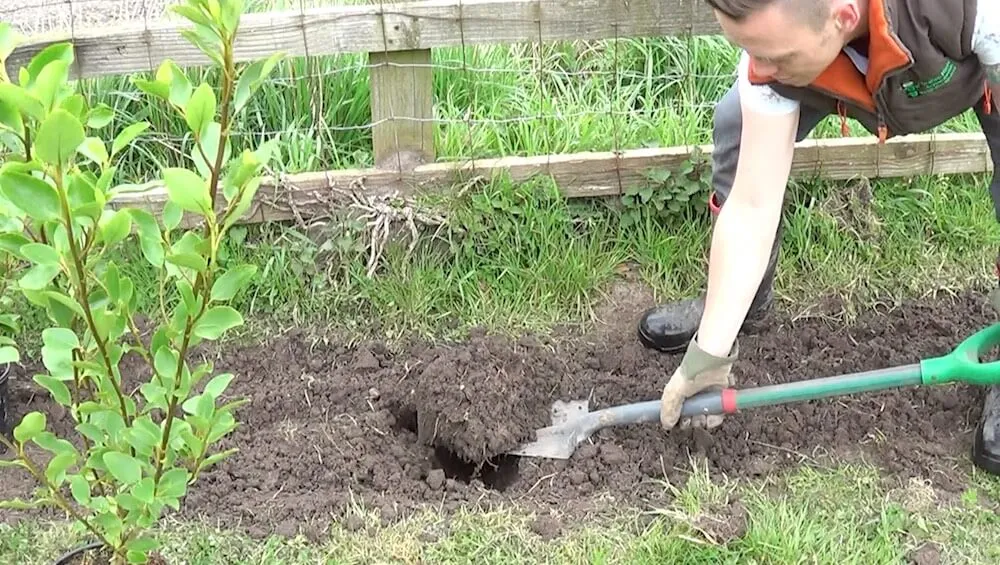
Loosen the soil around the planting site with a garden fork ready to then dig the planting hole or tree pit, as gardeners sometimes call them. This will make it far easier for the tree to send out new roots that are trying to break through compacted soil.
The size and depth of the hole are vital for the tree's long-term health. Dig a hole that is wider than the root ball and aim for at least 1.5 times the width of the container or bare root size.
Ensure that the hole's depth is enough to accommodate the root ball without burying the trunk too deeply.
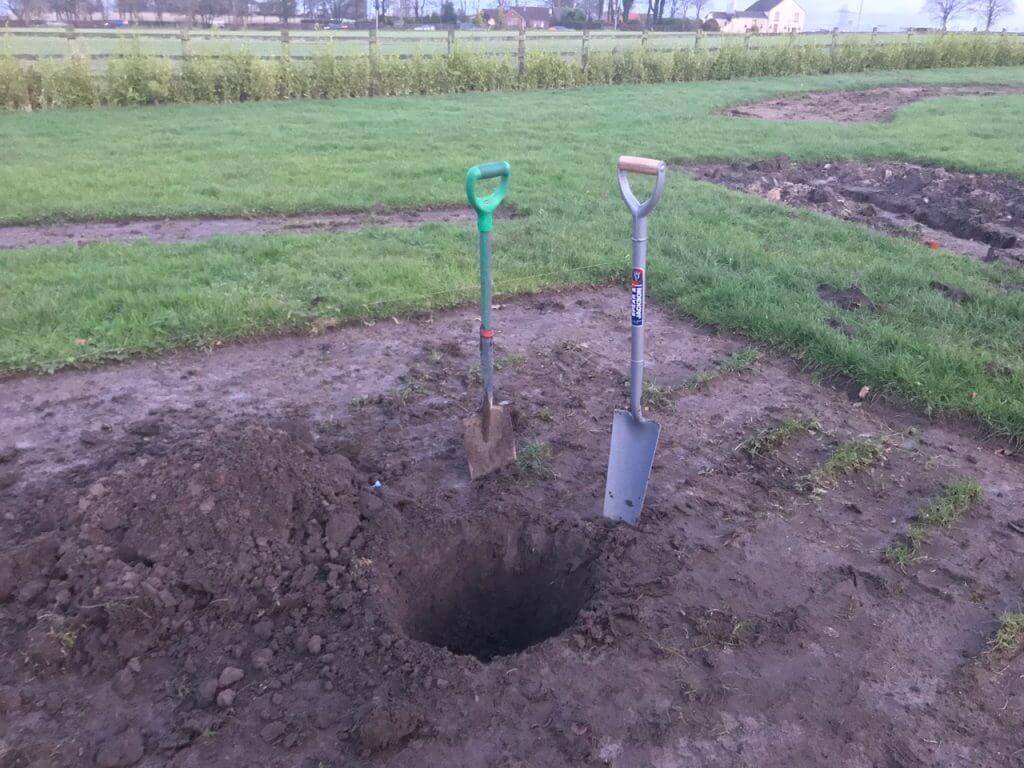
If you bury the tree deeper than the level of the pot, you can bury the tree graft and kill the tree as this union can rot if underground. So always make sure the level of the soil in the pot matches the ultimate planting depth in the soil or ground when transplanting a tree.
Gently place the tree in the centre of the hole and lift and wiggle it until it sits comfortably in place. Spin it around a few times and stand back to find the most pleasing position for the tree.
Ensuring that the root collar (the point where the roots flare out from the trunk) is level with or slightly above the surrounding soil.
This collar is sometimes called the crown or graft of the tree.
Ensuring the collar is level with the soil prevents the tree from being planted too deeply, which can harm its health. Burying too deeply can cause the trunk to suffocate or rot. Take care not to damage the roots during this process. If they won't fit comfortably in the planting hole, dig a wider hole.
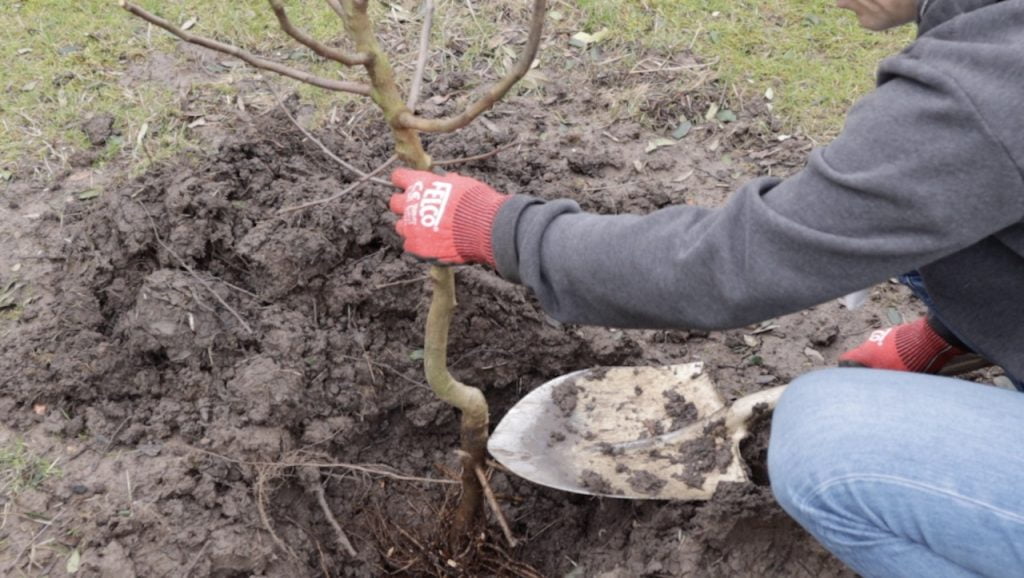
See the above picture where I'm using a spade to ensure I don't bury the tree deeper than the top of the rootstock.
Before backfilling with soil, it's worthwhile teasing the roots out to loosen them.
Especially if the roots have bound together in a swirled mass, this gives them a better chance of establishing. Pull the roots apart using your hands so they are not all stuck in one bundle. Meaning some fall free and hang rather than being stuck together.
Loosening and teasing the roots from their container or root ball will make it easier for the tree to send out its root for anchorage into the soil.
Fill the hole with soil around the roots whilst holding the trunk level.
Use your heel to compress the soil in around the roots. This is called heeling in.
Don't be shy; you need good contact with compacted soil around the roots to help support the tree and ensure it can take up moisture and nutrients. If you're too delicate with the backfilling, the tree will fail to establish as it struggles to uptake water.
Always stand back before firming in to check the trunk is vertical and the tree is upright.
Believe it or not, all plants have a good side and a back side. Spin the tree until the good side is forwards. You can spot this as it's well-rounded and looks balanced. Whereas the back side, away from the sun, is usually flatter.
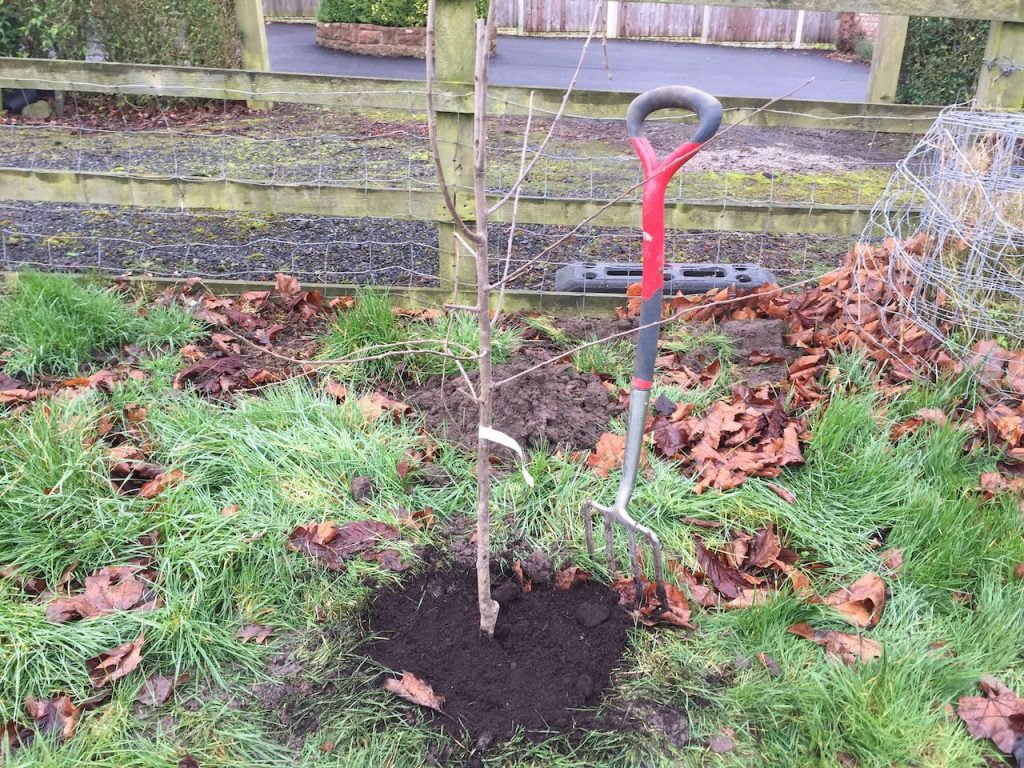
Firm the soil around the roots to eliminate air pockets. Then water the tree thoroughly to settle the soil and provide initial hydration for your tree.
Apply a layer of organic peat-free mulch around the tree, leaving a gap around the trunk to prevent rotting. Mulching helps retain moisture, suppress weeds, and insulate the soil. It can help new trees settle in far faster than without. Use either peat-free compost, leaf mould or chipped bark.
Young trees often require support to withstand wind or other environmental factors. If necessary, use tree stakes and ties to provide temporary support. Ensure the ties are loose enough to allow some movement but tight enough to prevent excessive swaying.
Always stake a new tree to protect it from wind rock and also make sure that it grows straight and not at an angle.
Check the tree regularly to determine when it no longer needs support or if you need to loosen the tree tie off. As the tree grows, the trunk thickens, so loosening the tie means it doesn't bite into the bark and damage the tree.
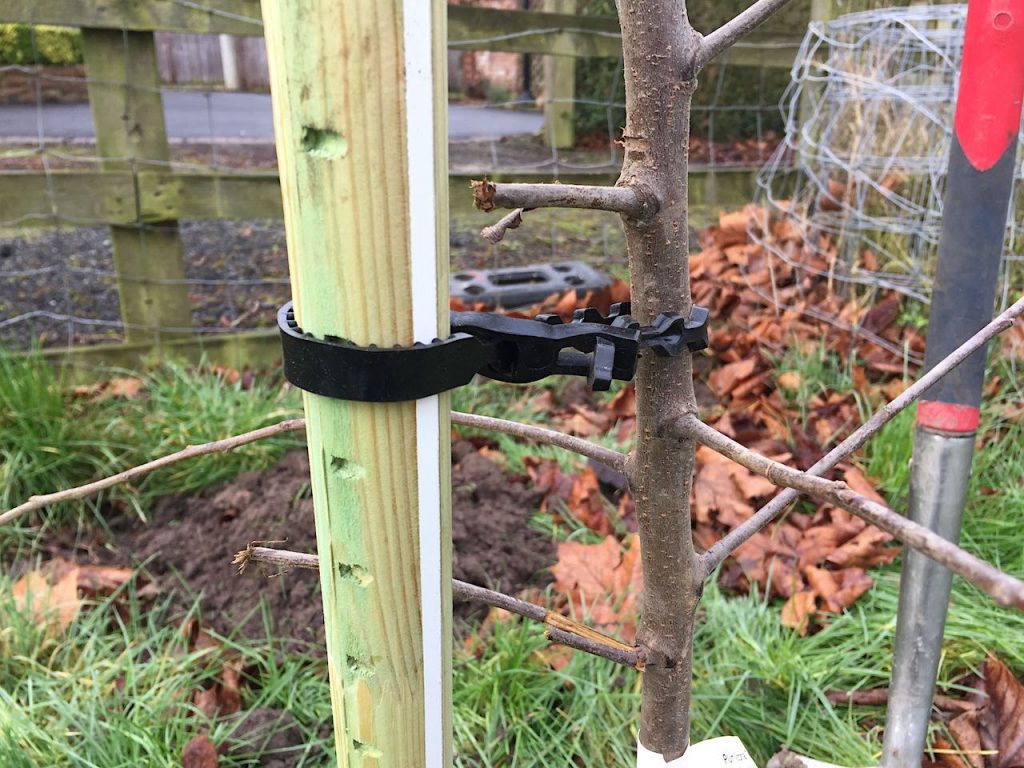
There has been some debate around the shape of the tree pit you dig for a new tree. Some argue that a round hole can simply encourage a trees roots to grow in a circular fashion around the root ball, meaning the tree doesn't reach out in all directions for new ground to ground itself in.
Other people recommend a square-shaped hole so as the trees roots start to grow, they hit a flat side and then 'break through' into open ground. But this is more supposition than science at this stage.
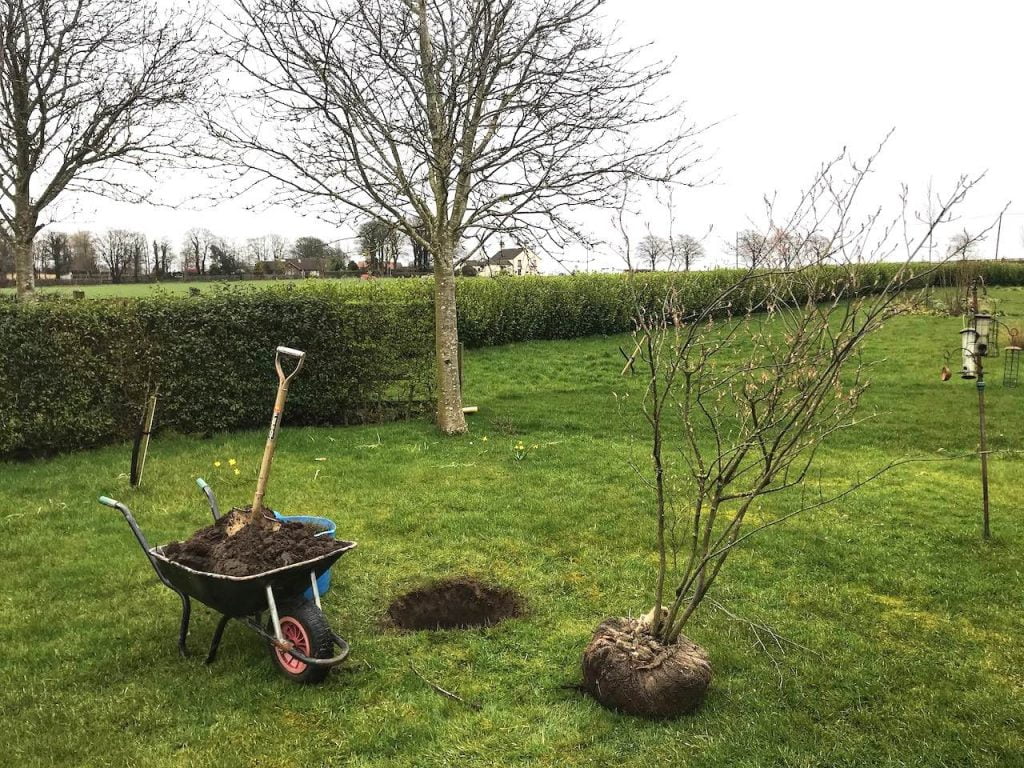
Other arborists think the square tree hole actually inhibits the tree's root growth as plants and rots tend to grow out in all directions. So they believe a round hole is better.
Tree roots tend to grow outward in a radial pattern from the trunk. A round hole allows the roots to spread more naturally and evenly in all directions. In a square hole, the roots may encounter the corners and be more likely to grow in a circling or girdling pattern, potentially leading to future root problems.
In my experience, a round hole with soil loosened 1.5x the width of the root ball works best. I have yet to see the benefit of square tree holes.
New trees are completely dependent on you for their water until they establish their roots.
You want to water a new tree 3 times a week for the first month.
This will ensure the tree has enough water to send out new roots. It's better to give a new tree a really good soak 3 times a week than a light water every day.
The key is to make sure the tree never fully dries out or is constantly wet either. One watering can per tree 3 times a week is enough in most cases.
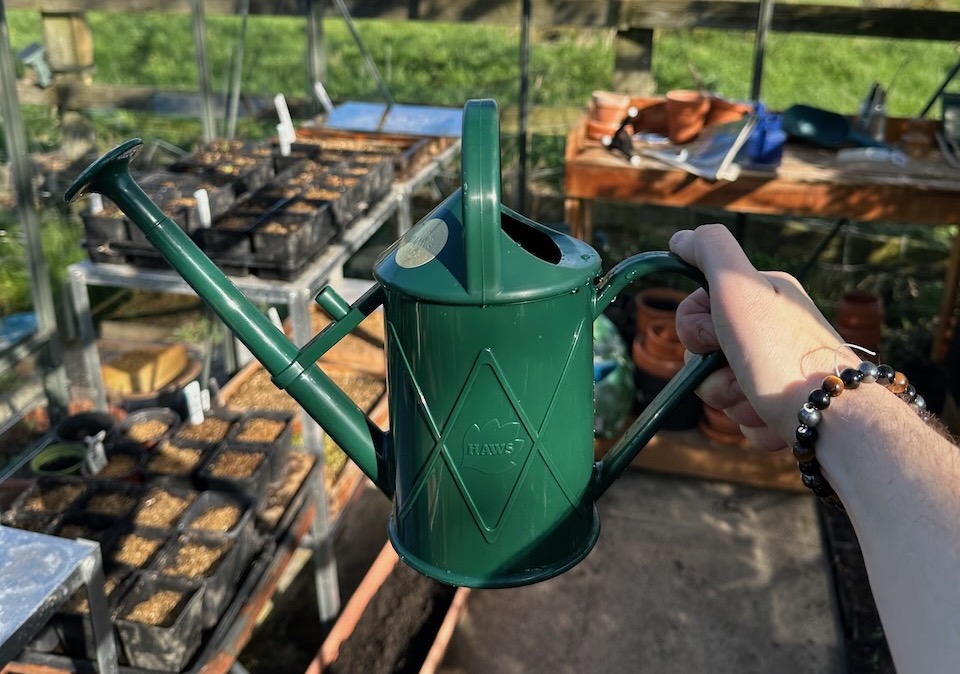
Pruning is crucial for shaping the tree and promoting healthy growth with any newly planted tree. Leaving awkward branches in place on a tree will lead to an unproductive or awkward looking tree. By using pruning to form the shape on younger trees branch structures, you can end up with a far nice tree than one that's just left to its own devices!
We call this formative pruning - to form the ultimate shape of the tree.
Always cut them back to the next branch down using clean, sharp secateurs. The guide on tree pruning below will show you.
Then work around the tree cutting any out-of-shape branches back to the next outward-facing bud and work around the tree pruning out any branches that are in the wrong place to form an equal and balanced shape.
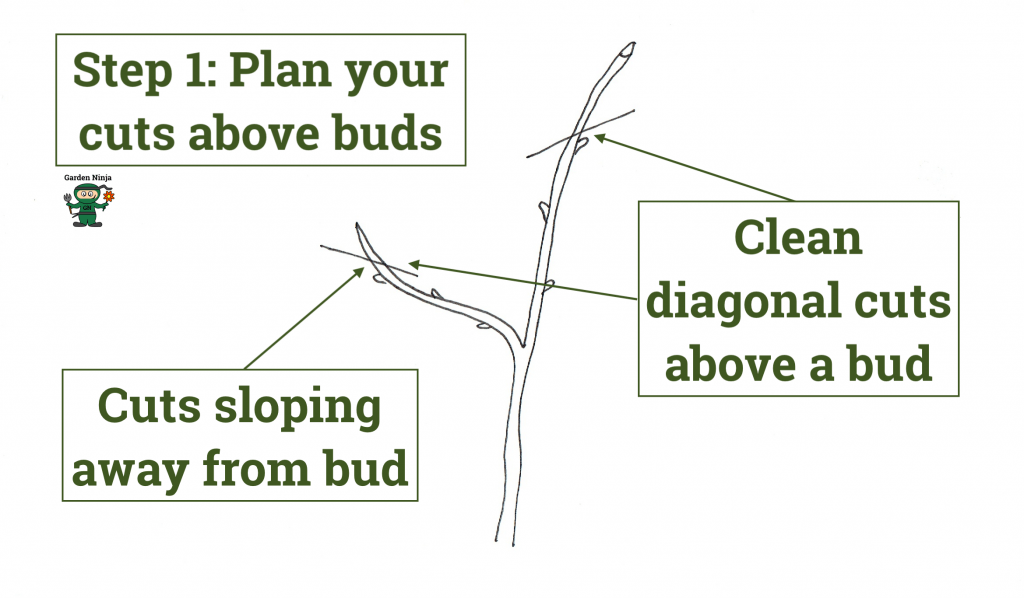
When it comes to selecting small garden trees for the UK, there are a number of wonderful suitable trees that are low maintenance and great for wildlife. No matter what size garden you have, even if a city garden that's tiny, there is a suitable tree for you that can enhance your garden and soften hard landscaping.
Below are my top 10 small garden trees that offer beauty, versatility, and suitability for beginner gardeners.
Crab apple trees are known for their stunning spring blossoms and decorative fruit. They come in various sizes, with some smaller cultivars reaching a height of around 2-4 meters. They offer a burst of colour and are often resistant to diseases. Their fruit offer food for the birds in late summer or can be used for jams and jellies for the keen grow-your-own gardener.
Have a look at Malus 'Everest' for a truly wonderful crab apple tree which is shown below in a multistem form.
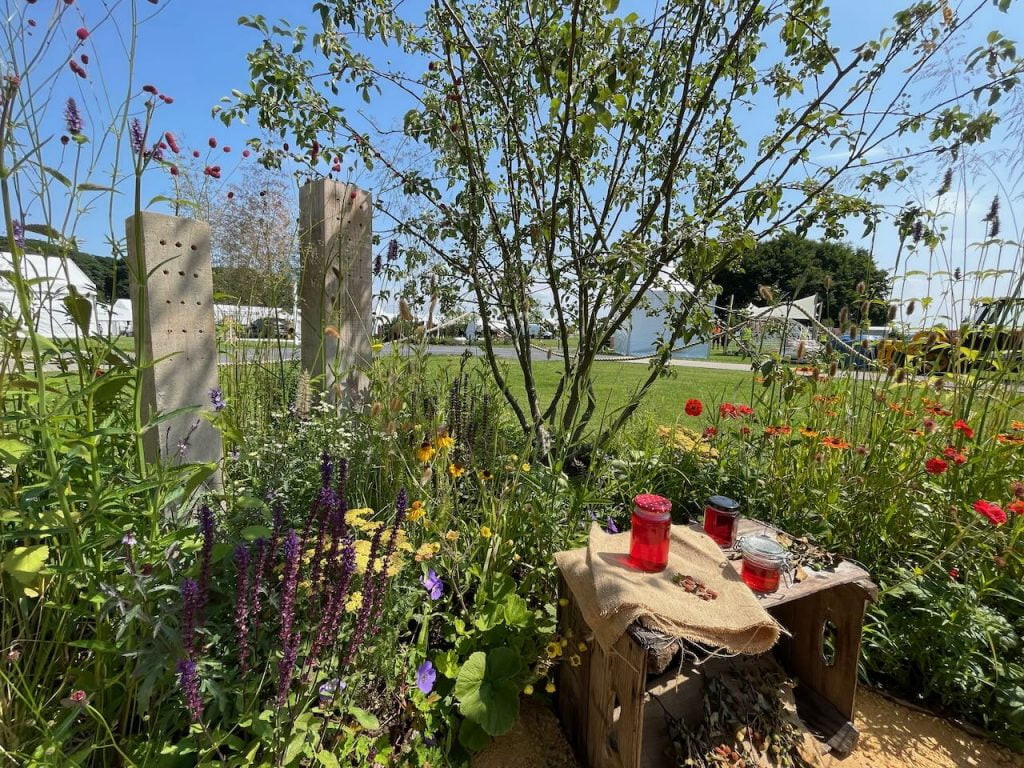
One of the most popular small garden trees that garden designers worldwide turn to! Also known as the Juneberry or Serviceberry, Amelanchier trees are prized for their beautiful spring flowers, edible berries, and vibrant autumn foliage. Offering 3 seasons of interest and then deciduous bare leaved structure in the winter.
They typically grow to a height of 2-6 meters and are suitable for small gardens, especially when chosen as a multistem form which has a number of thinner smaller trunks which can be planted like a large shrub.
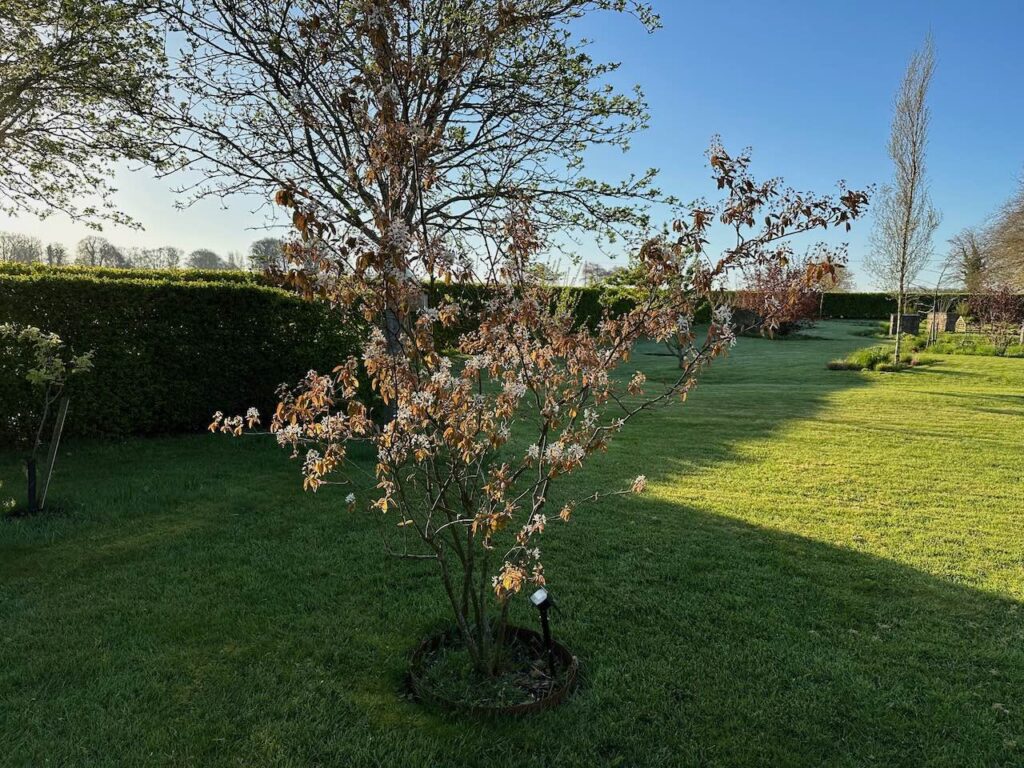
Japanese Maple trees or Acers are renowned for their delicate, lacy foliage and stunning autumn colours turning a multitude of colours from red, purple the orange as their colouration fades. They come in a range of sizes, including compact varieties that are ideal for smaller spaces. These trees thrive in partial shade and provide an elegant focal point in any garden.
The one thing with Acers is avoiding wind and exposed sites as the leaves burn easily. Acers do lend themselves well to container gardening or sheltered balcony sites too.
Have a look at Acer 'Sango Kaku' for a delicious specimen.
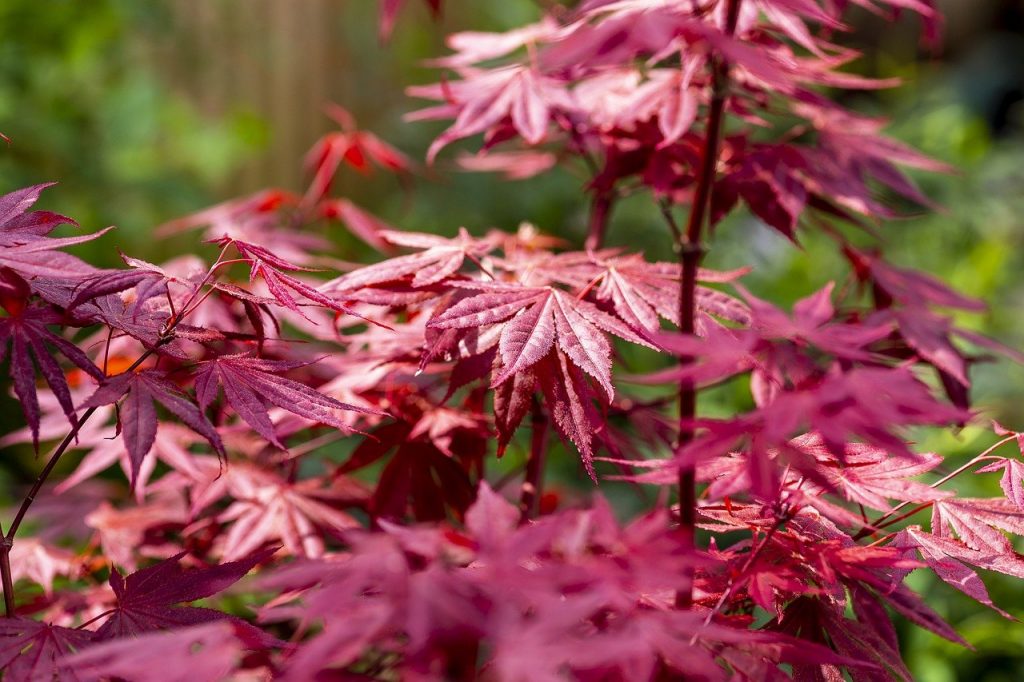
Rowan trees, or Mountain Ash, are native to the UK and offer a mix of attractive features for a small garden tree. They showcase clusters of white flowers in spring, followed by vibrant red or orange berries in autumn, which are a food source for birds. Mythology suggests that Rowan trees can keep demons and bad spirits away from them and have been used in witchcraft for centuries!
Compact varieties are available that grow to around 3-5 meters in height, such as Sorbus 'Joseph Rock'.
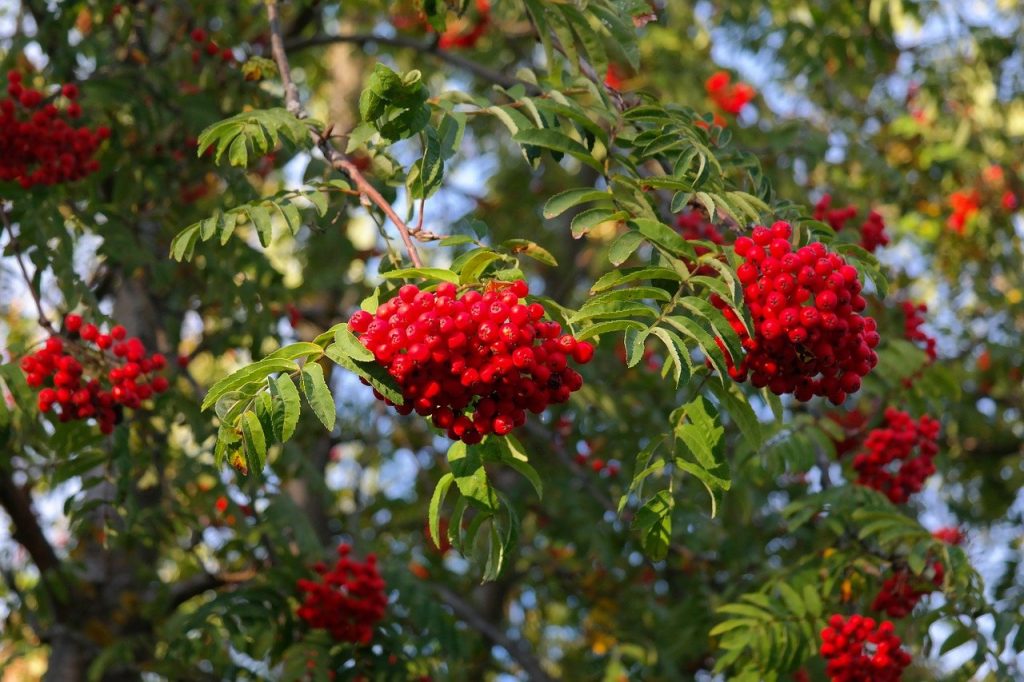
Hawthorn trees are native to the UK and are known for their abundant white or pink spring blossoms and red berries in autumn. As they are native they are easily identified by wildlife and establish quickly as they are used to our climate, hence the term 'native'.
These thorny trees make great hedges to warn off intruders and are super hardy trees for the UK. They provide valuable wildlife habitat for birds, moths and squirrels and can be pruned to maintain a smaller size using hard pruning methods. Which means they are also suitable for gardens with limited space. When pruning, wear gauntlets or thick gloves given the large woody thorns.
Try Crataegus grignonensis for a small Hawthorn tree specimen with a nice open-airy habit.
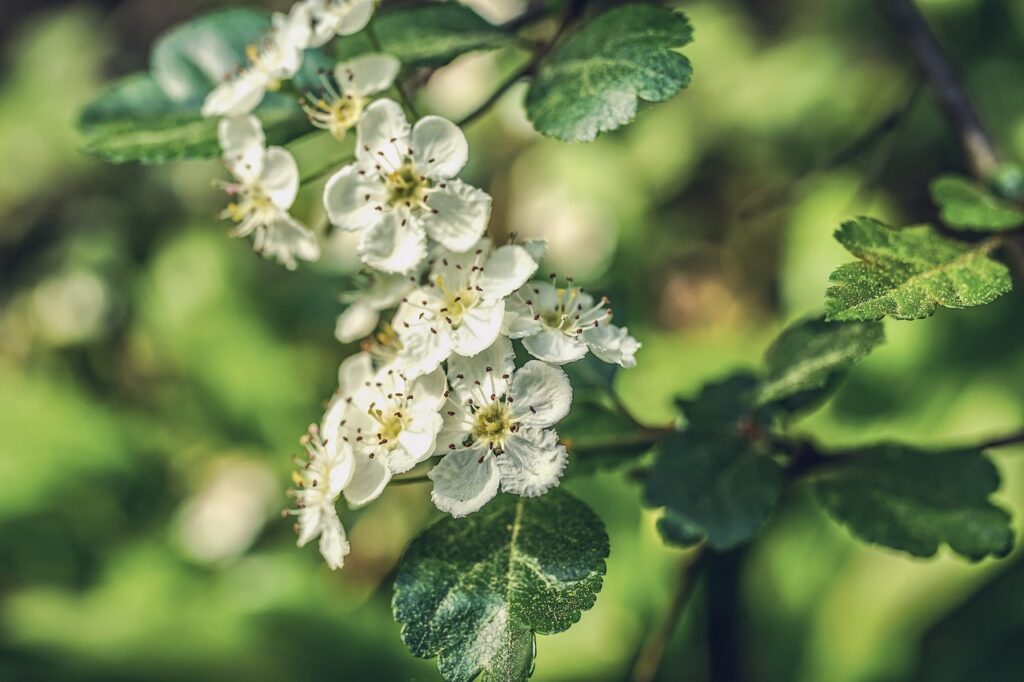
Silver Birch trees are elegant, slender trees with delicate, airy foliage and attractive silvery-white bark. Leaf fall isn't a problem as the small leaves tend to break down quickly and are rarely slippy in winter compared to other large leafed trees.
Another garden designer staple tree for impact with its bright white slender trunks. They thrive in the UK climate and can reach heights of 10-20 meters, but fastigiate or multistem formats keep their stature far smaller.
Look up Betula utilis 'Jaquemontti' for one of the best small garden birch trees.
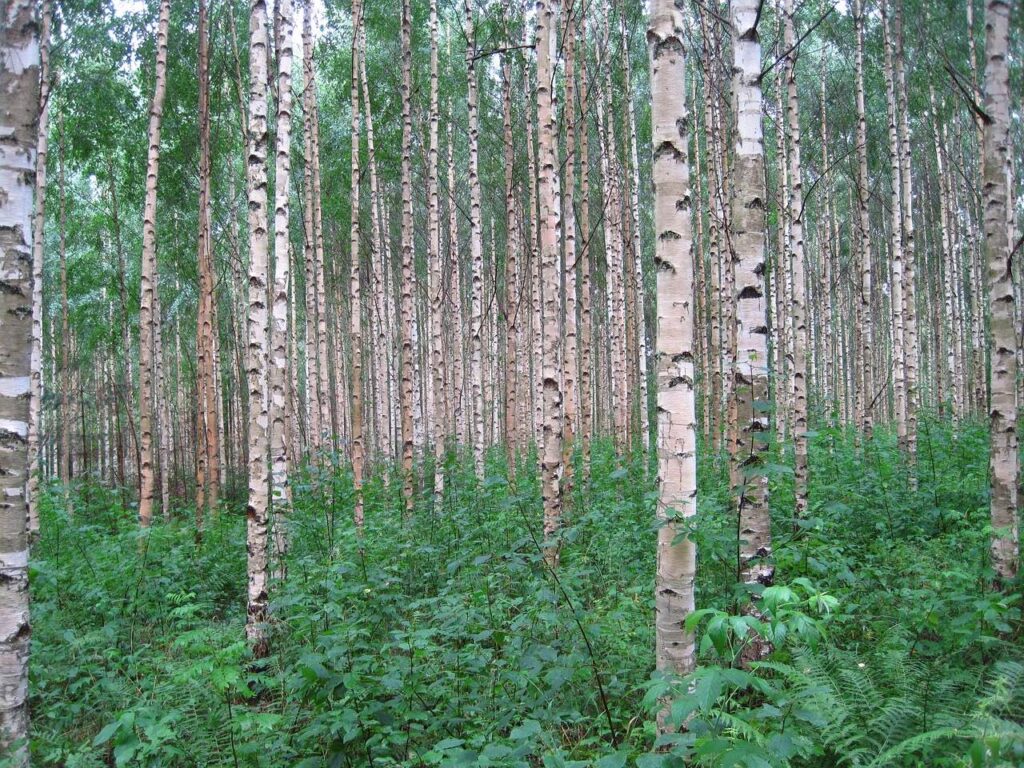
Flowering Cherry trees or Prunus are prized for their captivating spring blossoms, ranging from delicate whites to vibrant pinks. Similar to the fruiting cherry, these specimens still fruit, although they are not always edible without cooking. Cherries have a very solid trunk and branch structure with little flex. Great for wildlife gardens or if you need a fast-growing tree to provide privacy.
Try Prunus padus (the bird cherry) for a good value quick-growing small garden tree.
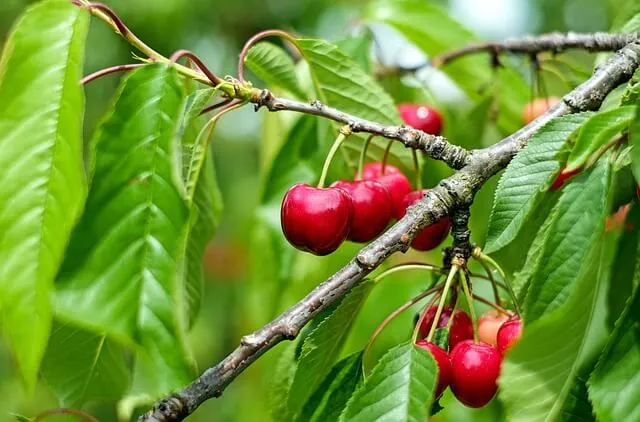
Possibly one of the slowest-growing and smallest of all the Pine tree genera is Pinus mugo. Often used in Japanese garden design styles or micro gardens, this tree can fit anywhere. It grows at such a slow rate of maybe 1 -2 inches per year it can be pruned and kept compact. Great for small urban gardens or pocket gardens.
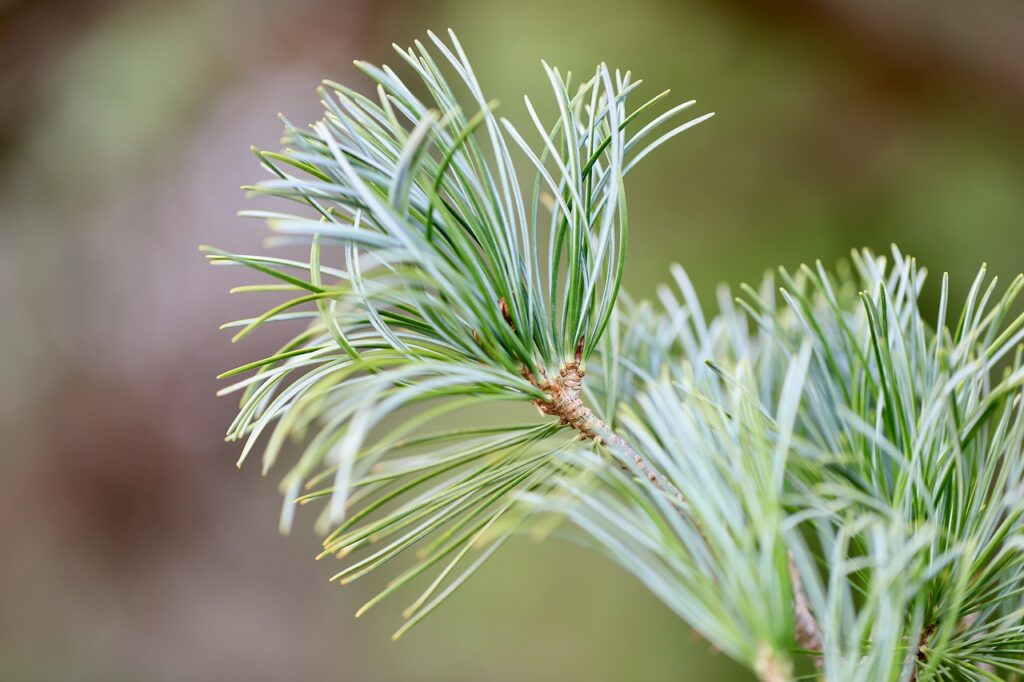
Fancy an unusual small evergreen tree that had bright red fruits? Then look no further than the Strawberry tree, Arbutus unedo. These trees prefer full sun but will grow in pretty much any soil conditions. They have rough shedding red-brown bark and green leathery leaves. They can grow up to 8m but multi-stem varieties are much smaller and well-behaved.
The flowers are white and urn-shaped in panicles (flower-packed side shoots off a branch) to 5cm long. The strawberry-like red fruits from the previous years' flowers ripen in year two, giving the name its strawberry common name.
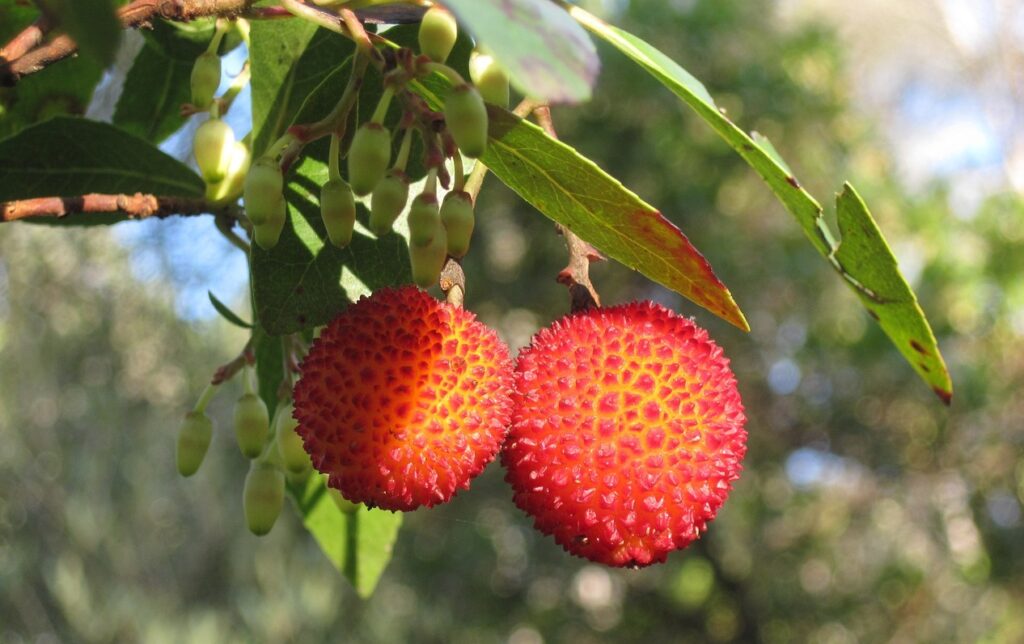
If you're looking for a tropical small garden tree, then the Canary date palm is pretty much unbeatable. It's hardy down to -5 degree Celsius and in warmer climates, you may even get date fruits! It's a prime plant for a container garden that can be moved under glass in harsh winters.
The Canary Date Palm is a slow-growing palm, especially when young. It may take several years to develop a noticeable trunk height. However, its slow growth rate contributes to its longevity, and mature specimens can live for many decades.
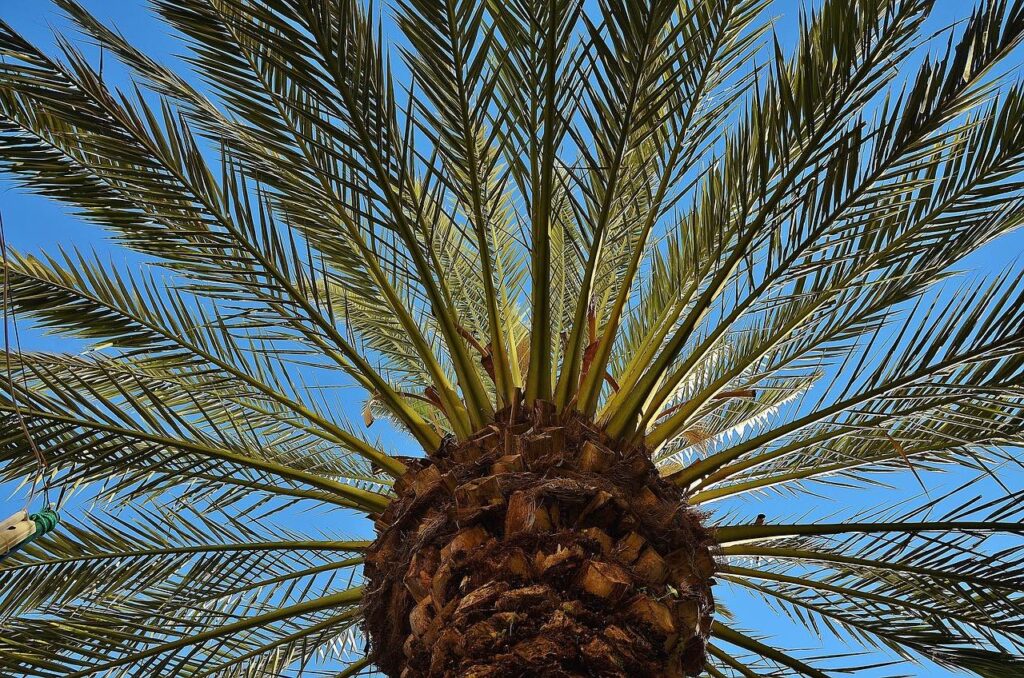
The Canary Date Palm is relatively low-maintenance. Regular watering and occasional fertilization can help it thrive if in a pot or container garden. Pruning is generally limited to removing dead fronds or fruit stalks to maintain a tidy appearance and safety.
Tree positioning is an important factor when planting trees in a garden. So many time I see gardeners planting trees right at the boundary edge of gardens. Meaning they are crammed in, likely to grow over neighbouring gardens and cause issues along with making the garden feel really closed off.
Always consider the ultimate growth, height and shape of the tree before positioning them.
One of the biggest complaints people have about trees is the shading cast by poorly positioned trees.
Usually, an eager gardener plants trees without considering how big they will grow and in what shape. Always plant with the ultimate height and growth in mind. Some shade cast by trees can be a benefit in keeping your garden cooler in the warmer months. However, the amount of shade needs to be thought about.
Generally, a multistem deciduous tree will cast less shade than a large evergreen tree that blocks out light. Lleylandii, I'm talking about you!
If you do have a tree that's casting shade or has seemingly grown too big, please don't just rip it out. Consider crown lifting the tree first, the process of pruning out lower branches to increase light and reshape the tree. It's often far better for wildlife, saves money and means you do not have to replace an established tree with a smaller one!
Planting trees is a simple yet powerful way to contribute to a greener future. They add beauty and function to all gardens, no matter what size. Enabling wildlife to take shelter in our urban areas and also provide blossom, beautiful leaves and even fruit to our garden spaces. Trees also provide much-needed height, which a lot of designs fail to incorporate. In my opinion, every garden, no matter what size, should have at least one tree!
By following this step-by-step guide, you can ensure the successful establishment of trees. This, in turn, makes a positive impact on the environment and future generations. Remember, each tree planted brings us one step closer to a more sustainable and resilient planet.
Make sure you visit my Youtube channel, for more gardening guides. You can also check out my Tweet, Facebook or Instagram for more garden help and tips.
Happy gardening!


You must be logged in to post a comment.

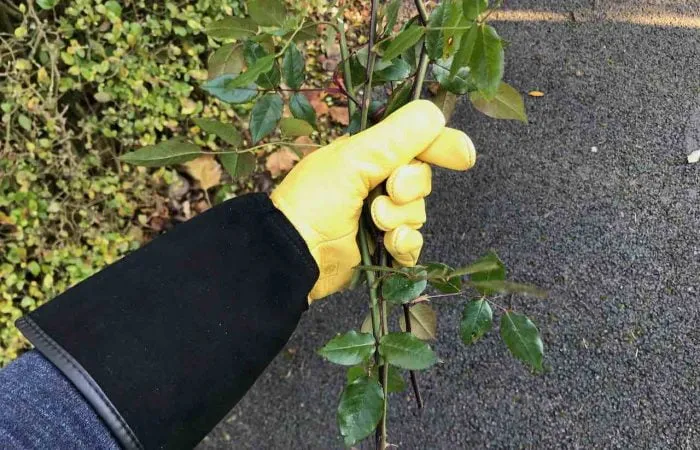
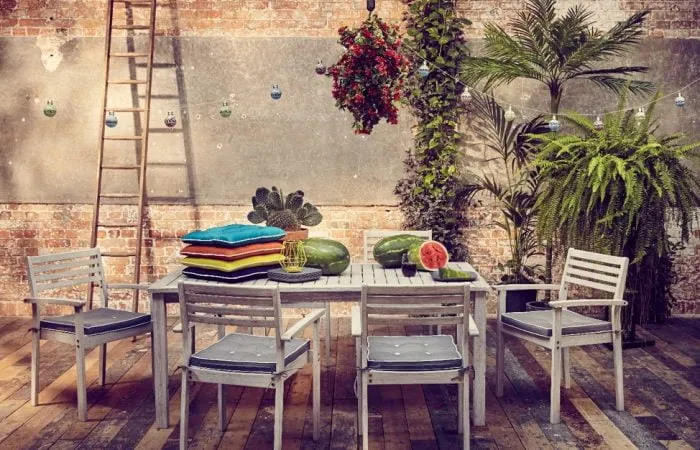
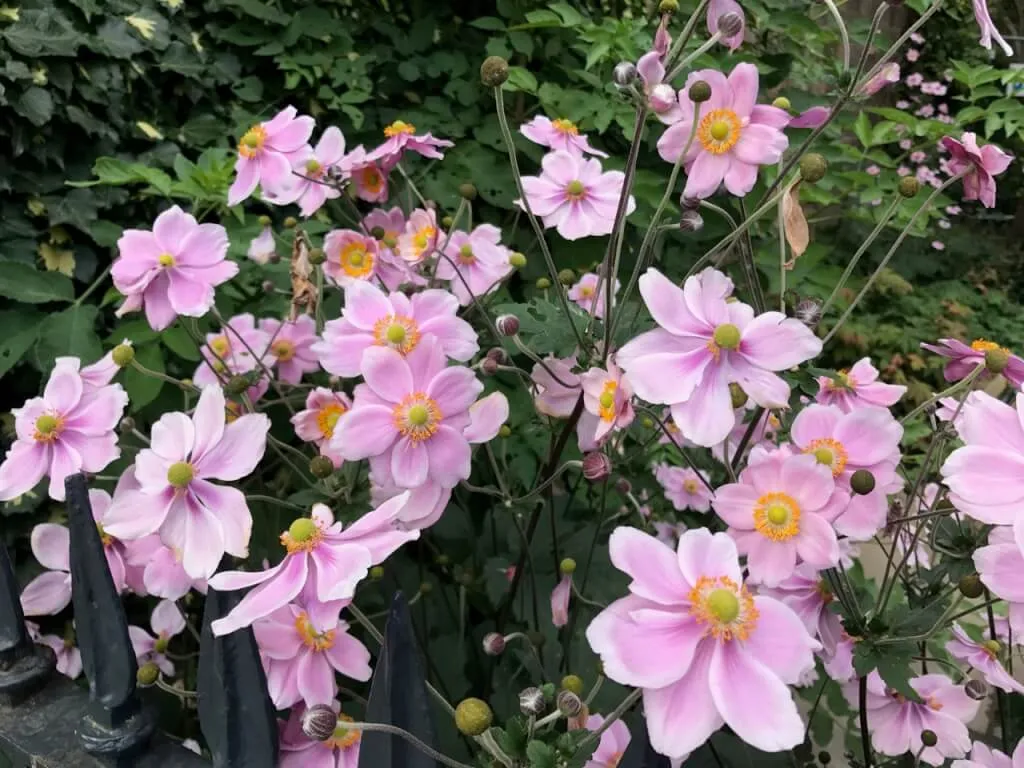
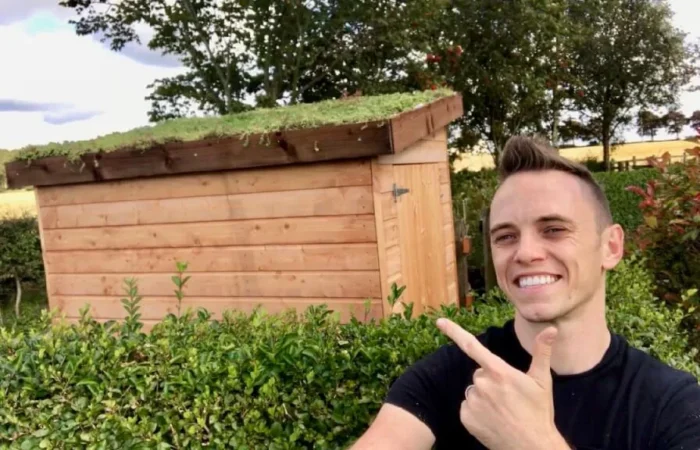
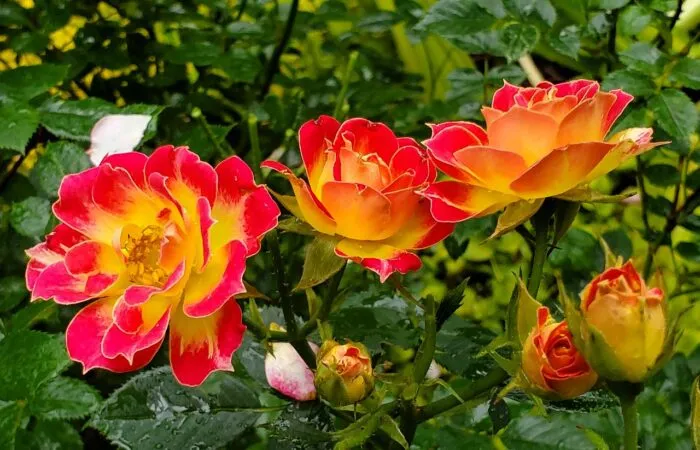
JOIN THE NINJAS

Be the first in line for new Guides, Discount codes and Offers
Such a helpful post , invaluable to me as a newbie tree planter! You mention taking into account height and spread of when choosing trees for the garden. Can you recommend a source that I can use to quickly check height and spread of particular trees? Thanks
Hi Emma. The RHS plant finder has useful information on the ultimate height and spread of the plants they list so give that a go! https://www.rhs.org.uk/plants